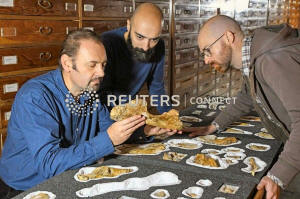|
Big dinosaur predator from Italy was
given a burial at sea
 Send a link to a friend
Send a link to a friend
 [December 26, 2018]
By Will Dunham [December 26, 2018]
By Will Dunham
WASHINGTON (Reuters) - Scientists have
unearthed fossils of a large meat-eating dinosaur that stalked northern
Italy 198 million years ago that was remarkable both in life and in
death.
The researchers said on Wednesday Saltriovenator zanellai was about 25
feet long (7.5 meters) and weighed at least a ton, meaning that when it
lived early in the Jurassic Period it was the largest-known carnivorous
dinosaur that had ever existed.
Its demise also was noteworthy.
After dying, the Saltriovenator's carcass somehow floated into the sea
and sank to the bottom, where it was scavenged over a period of months
or years by numerous marine creatures before fossilizing, the
researchers said. The bones bear marks likely left by the gnawing of
sharks and fish as well as signs of feeding by invertebrates such as sea
urchins and tiny holes penetrating the bone apparently left by marine
worms.

"This is absolutely unique," said Milan Natural History Museum
paleontologist Cristiano Dal Sasso, who led the research published in
the scientific journal PeerJ. "In the scientific literature, there is
mention of some dinosaur bones scavenged only by terrestrial animals,
such as other dinosaurs, and, more rarely, insects. At least three kinds
of marine animals left those traces on the bones of Saltriovenator."
Saltriovenator, which combined traits of primitive meat-eating dinosaurs
with those of more advanced ones, foreshadowed a succession of even
bigger predatory dinosaurs that lived later in the Jurassic and in the
Cretaceous Period. It is the second dinosaur ever unearthed in Italy.
[to top of second column]
|

Paleontologist Cristiano Dal Sasso (L) and co-authors Simone
Maganuco and Andrea Cau (R) examine the bones of the Jurassic
dinosaur Saltriovenator, at the Natural History Museum of Milan,
deposited in the Museum collections in this undated handout photo
obtained by Reuters December 18, 2018. Gabriele Bindellini/Handout
via REUTERS

Saltriovenator, meaning "hunter from Saltrio," walked on two legs,
had a skull 2-1/2-feet long (80 cm) studded with sharp serrated
teeth and had hands with four fingers, three of which possessed
claws. It was about 24 years old, still not quite fully grown. It
lived in a coastal, Caribbean-like environment and likely hunted
plant-eating dinosaurs and maybe smaller carnivorous dinosaurs, the
researchers said.
Dinosaurs first appeared about 230 million years ago during the
Triassic Period. The earliest meat-eating dinosaurs were
overshadowed by larger non-dinosaur predators that died off by the
end of the Triassic. With the competition gone, there was a great
leap in size for carnivorous dinosaurs during the Jurassic.
The fossils were discovered in 1996 in a quarry near the village of
Saltrio, roughly 50 miles (80 km) north of Milan in Italy's Lombardy
region. This led to an arduous process of extracting the bones from
the hard surrounding rock.
(Reporting by Will Dunham; Editing by James Dalgleish)
[© 2018 Thomson Reuters. All rights
reserved.]
Copyright 2018 Reuters. All rights reserved. This material may not be published,
broadcast, rewritten or redistributed.
Thompson Reuters is solely responsible for this content.
|